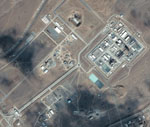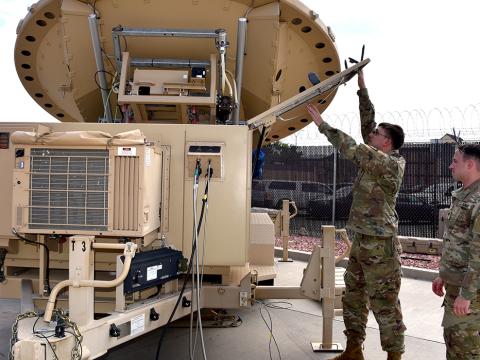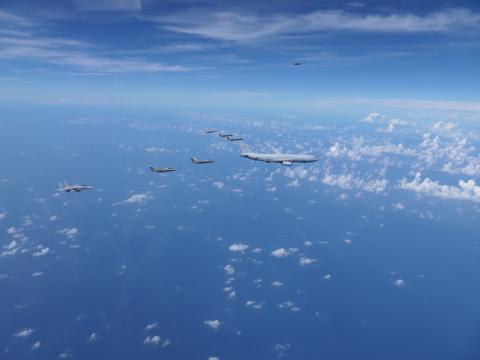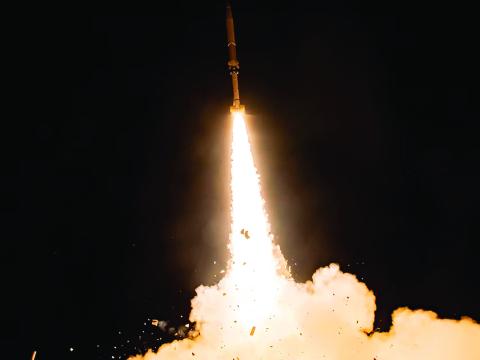Space Vulnerabilities Threaten U.S. Edge in Battle
 |
| A Boeing Delta IV, the U.S. Air Force’s newest heavy-lift launch vehicle, blasts off from Cape Canaveral Air Force Station in Florida. Once the realm of only a handful of nations, space access is opening up to many other nations, which promises to erode U.S. superiority in that arena. |
The proliferation of space technologies around the world poses a threat to the space assets on which the U.S. military is relying to ensure battlespace supremacy in the 21st century. These technologies, once available only to a select few, now are opening the door to both the widespread exploitation of space and the denial of U.S. space systems during times of crisis.
This development could affect future U.S. military operations in a number of ways. The edge that U.S. forces have in using space assets almost exclusively will weaken as other nations—and even terrorist organizations—are able to take advantage of space-based capabilities. This might include intelligence, surveillance and reconnaissance assets that could be used to lift the veil off of U.S. force operations. Even the satellite communications that form the backbone of mobile operations are within reach of adversarial forces.
Countermeasures against U.S. space assets also are becoming easier to acquire. More countries than ever now have launch-to-orbit capabilities, which increases the possibility of rogue nations placing antisatellite payloads in space to attack U.S. orbiters. And, some emerging technologies offer the potential of empowering terrorists with inexpensive antisatellite measures that could remove vital U.S. orbital assets from the battlespace.
Not only are previously restricted space technologies becoming more commonplace, but also the cost of their deployment and use is dropping. In effect, the dues for joining the spacefaring club are shrinking, and membership is growing.
These conclusions are part of a report assembled by the U.S. Air Force National Air and Space Intelligence Center, Wright-Patterson Air Force Base, Ohio. Titled “Challenges to U.S. Space Superiority,” the report describes how the overwhelming U.S. superiority in space will erode as a result of several trends already underway.
Foremost among these trends is the proliferation of space technologies that previously have been limited to technologically advanced countries with large bankrolls. The availability of smaller satellites that are less expensive to build and cost less to launch is allowing more nations to place assets in orbit.
Many countries now are developing satellites for remote sensing, communications, navigation, imagery and missile warning. Not only are many of these capabilities for sale or rent, but their continuing evolution also is bringing down the cost of acquiring such systems. The near-monopoly on intelligence and other capabilities generated by these satellites will disappear as new orbiters come online. U.S. military forces no longer will have the luxury of being able to conceal their activities from enemy satellites because they pass overhead only on rare occasions.
Remote sensing capabilities have improved to the point where commercial satellites now are able to provide imaging resolution that was available only to the military less than a generation ago. And, that capability is becoming less expensive. Today’s best commercial remote sensing satellites can provide slightly better than 1-meter resolution. But, a customer can attain better than 3-meter resolution by paying only $18 million for a remote sensing platform and the launch services necessary to place it in orbit, the report states. This includes the ground services necessary for downlinking the imagery.
Synthetic aperture radar (SAR) satellites have improved to where they also can provide 3-meter resolution, and this will lead to more of these orbiting sensors being deployed. They can image day or night and through a variety of adverse weather conditions, including heavy cloud cover.
Panchromatic and multispectral remote sensing imaging systems with a ground sample distance of less than 3 meters now can be built on a satellite bus no larger than a big-screen television, the report adds. These sub-500-pound satellites, along with other small imaging orbiters, are bringing launch costs within reach of many countries. The report observes that nations that previously lacked indigenous space capabilities are buying their own satellites and pooling their data with subscribed partners. Countries such as Algeria, Nigeria, Turkey and South Africa have taken this approach to space access.
Even ballistic missile early warning (BMEW) and electronic intelligence (ELINT) satellites, historically the purview of only the United States and Russia, soon will be showing up in other nations’ inventories. The report predicts that Russia will deploy a next-generation ELINT system and more BMEW satellites by 2010, and France and China are establishing testbed systems in both disciplines.
Communications satellites—the core of network-centricity—are serving all manner of customers, including foreign armies and terrorists. While only a few nations can develop their own orbiters, many are purchasing commercial off-the-shelf communications satellites to build their own global information infrastructure. These and other nations also are leasing a full range of communications capabilities from commercial service providers. Even individuals can purchase handheld satellite telephones and modems for worldwide links.
Satellite navigation has found a home in many applications, and several nations are joining the United States in orbiting constellations. Joining the U.S. Global Positioning System (GPS) and the Russian Global Navigation Satellite System (GLONASS) will be China’s BeiDou and Europe’s Galileo systems. China already has three BeiDou satellites in orbit, but they cannot provide the three-dimensional (3-D) precision location inherent in GPS and GLONASS. More satellites are planned for the constellation, which will add this and other capabilities. Europe’s Galileo, when it comes online in 2010-2012, would provide 1-meter 3-D accuracy. Improvements planned for GPS, GLONASS and BeiDou will bring those three systems in line with Galileo’s design performance. This will allow other nations to choose among the systems or to incorporate receivers capable of interoperating with all four constellations.
 |
| This February 2005 image from DigitalGlobe shows a complex at Arak, Iran, that is believed to harbor nuclear research that may be aimed at developing a weapon. The image is an example of how commercial remote sensing platforms can provide high-resolution imagery that used to be available only to a handful of governments. |
Both military and commercial space assets are threatened, and the military relies on both for some of its communications, weather reporting and navigation. Three types of offensive counterspace operations are identified: ground segment attack or sabotage, electronic attack and space segment attack using antisatellite systems.
Even low-technology groups such as terrorists can disrupt space assets through ground attack. Critical ground facilities associated with U.S. space systems can be struck by organized terrorists or by foreign special operations forces. All an adversary needs is to glean information about which ground facilities are critical—especially those that offer a single-point-of-failure vulnerability—and where they are located. The report adds that many fixed U.S. satellite communications, data reception and control facilities are described in open-source materials.
Electronic attack can take two forms: uplink jamming or downlink jamming. All military and commercial satellite communications systems theoretically are susceptible to both types of jamming, the report states. Uplink jamming targets a satellite’s radio receivers, including sensors and command receivers, and it usually requires high-power transmitters. It can have global effects if the satellite receiver is used by customers located over a large area.
The report cites an incident that took place in July 2003 when someone bent on disrupting digital television and radio broadcasts to Europe and the Middle East intentionally jammed two transponders of Telstar 12, a commercial communications satellite. The report states that both transponders carried programming “likely to be offensive to the Iranian government.” These broadcasts included the U.S. government’s Voice of America Persia as well as private commercial radio and television channels.
Downlink jamming can take many forms, and it can affect communications links as well as satellite navigation signals. While its effects largely are local, it requires much less power to be effective. During the Iraq War, Saddam Hussein’s forces employed GPS jammers against coalition forces. This attempt to disrupt GPS systems ultimately failed, but it brought home that adversaries will attempt to neutralize U.S. space-based assets, according to then-Air Force Secretary James G. Roche.
Russia openly markets a device that it claims can block GPS signals, and some GPS receivers reportedly have been jammed by systems built from parts purchased at hobby shops. The report notes that a National Aeronautics and Space Administration (NASA) satellite data reception facility was inadvertently jammed by nothing more than a malfunctioning automobile alarm in its parking lot.
The most difficult form of attack to execute would be using antisatellite systems. These likely would be low-altitude, direct ascent interceptors fired into low earth orbit; low-altitude, co-orbital interceptors that would be launched from the ground into a low earth orbit; high-altitude short-duration interceptors deployed from a large space vehicle into a parking orbit from which it would attack a geosynchronous satellite; or long-duration orbital interceptors that would sit in a storage orbit until ordered to inspect or attack a U.S. satellite. These long-duration orbiters could include space mines, orbiting interceptors and space-to-space missiles.
Russia has the most advanced antisatellite attack capability of any nation or organization. Defense analysts believe that its antiballistic missile interceptors may have inherent antisatellite capability. A Russian arms catalog actually illustrates a co-orbital antisatellite system’s flight profile right up to impact on a target satellite.
In addition to explosive or kinetic kill vehicles, antisatellite weaponry includes directed energy systems. They tend to be more difficult to obtain or develop than kinetic vehicles and their capabilities are limited, but they offer the advantage of a single system being able to hit multiple targets.
Ground-based lasers can damage thermal control, electro-optical, structural and power generation components on low-earth-orbit satellites. Airborne high-power lasers operating above much of the atmosphere also can damage components on low-earth-orbit satellites. Even low-power lasers, which could be deployed in orbit on small satellites, can blind or damage sensors by operating at the same wavelength as the sensor. The report states that open sources claim China has the ability to blind U.S. satellites.
Several countries are developing radio frequency beam weapons that emit intense beams either in narrowband or wideband configurations. These weapons could be ground- or space-based and could offer single or multiple shots.
And, many countries are learning how to identify and track U.S. satellites. While Russia long has had a network of ground-based space object surveillance and identification sensors, other countries are developing or acquiring the capability. The report cites China, France, Japan and South Korea as nations that are developing these sensor systems. Other countries that cannot indigenously develop space object surveillance sensors can purchase them to build their own networks.
But even if buying or building a sensor network is beyond reach of a country or a terrorist organization, adversaries can obtain low-earth-orbit satellite tracking data from the Internet. Many global amateur satellite watching associations post tracking data on the Web, including that of reconnaissance satellites. Nations or nongovernmental organizations that do not want to rely on these amateur groups easily can duplicate their low-technology methods, the report notes.
Web Resources
National Air and Space Intelligence Center: www.wpafb.af.mil/naic
U.S. Air Force Space Command: www.peterson.af.mil/hqafspc
U.S. Strategic Command: www.stratcom.mil




Comments